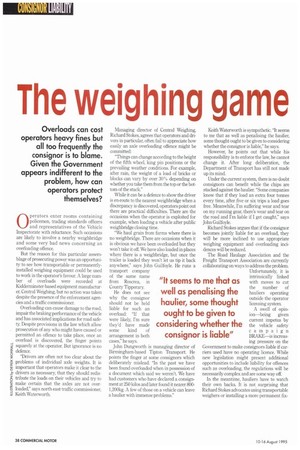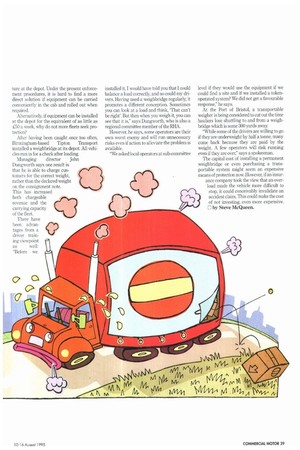The weighing game
Page 40

Page 41

If you've noticed an error in this article please click here to report it so we can fix it.
Overloads can cost operators heavy fines but all too frequently the consignor is to blame. Given the Government appears indifferent to the problem, how can operators protect themselves?
Operators enter rooms containing policemen, trading standards officers and representatives of the Vehicle Inspectorate with reluctance. Such occasions are likely to involve a nearby weighbridge and some very bad news concerning an overloading offence,
But the reason for this particular assemblage of prosecuting power was an opportunity to see how transportable or permanentlyinstalled weighing equipment could be used to work in the operator's favour. A large number of overloads were recorded at Kidderminster-based equipment manufacturer, Central Weighing, but no action was taken despite the presence of the enforcement agencies and a traffic commissioner.
Overloading can cause damage to the road, impair the braking performance of the vehicle and has associated implications for road safety Despite provisions in the law which allow prosecution of any who might have caused or permitted an offence to take place, once an overload is discovered, the finger points squarely at the operator. But ignorance is no defence.
"Drivers are often not too clear about the problems of individual axle weights. It is important that operators make it clear to the drivers as necessary, that they should redistribute the loads on their vehicles and try to make certain that the axles are not over. loaded," says north east traffic commissioner, Keith Waterworth. Managing director of Central Weighing, Richard Stokes, agrees that operators and drivers in particular, often fail to appreciate how easily an axle overloading offence might be committed: "Things can change according to the height of the fifth wheel, king pin positions or the prevailing weather conditions. For example, after rain, the weight of a load of bricks or blocks can vary by over 30% depending on whether you take them from the top or the bottom of the stack."
While it can be a defence to show the driver is en-route to the nearest weighbridge when a discrepancy is discovered, operators point out there are practical difficulties. There are the occasions when the operator is exploited for example, when loading a vehicle after public weighbridge closing time.
"We haul grain from farms where there is no weighbridge. There are occasions when it is obvious we have been overloaded but they won't take it off. We have also loaded in places where there is a weighbridge, but once the trailer is loaded they won't let us tip it back anywhere," says John Guilfoyle. He runs a transport company of the same name from Roscrea, in County Tipperary.
He does not see why the consignor should not be held liable for such an overload: "If that were likely, I'm sure they'd have made some kind of arrangement in both cases," he says.
John Dungworth is managing director of Birmingham-based Tipton Transport. He points the finger at some consignors which deliberately mislead. "In the past we have been found overloaded when in possession of a document which said we weren't. We have had customers who have declared a consignment at 250 kilos and later found it nearer 8001,200kg. A few of those on a vehicle can leave a haulier with immense problems." Keith Waterworth is sympathetic. "It seems to me that as well as penalising the haulier, some thought ought to be given to considering whether the consignor is liable," he says.
However, he points out that while his responsibility is to enforce the law, he cannot change it. After long deliberation, the Department of Transport has still not made up its mind.
Under the current system, there is no doubt consignors can benefit while the chips are stacked against the haulier. "Some companies know that if they load an extra four tonnes every time, after five or six trips a load goes free. Meanwhile, I'm suffering wear and tear on my running gear, there's wear and tear on the road and I'm liable if I get caught," says John Guilfoyle.
Richard Stokes argues that if the consignor becomes jointly liable for an overload, they will be more inclined to use appropriate weighing equipment and overloading incidences will be reduced.
The Road Haulage Association and the Freight Transport Association are currently collaborating on ways to address the problem. Unfortunately, it is intrinsically linked with moves to cut the number of hauliers operating outside the operator licensing system.
A swell of opinion—being given current impetus by the vehicle safety campaign BRAKE—is increasing pressure on the Government to make consignors liable if carriers used have no operating licence. While new legislation might present additional opportunities to include liability for offences such as overloading, the regulations will be necessarily complex and are some way off.
In the meantime, hauliers have to watch their own backs. It is not surprising that Richard Stokes advocates using transportable weighers or installing a more permanent fix ture at the depot. Under the present enforcement procedures, it is hard to find a more direct solution if equipment can be carried conveniently in the cab and rolled out when required.
Alternatively, if equipment can be installed at the depot for the equivalent of as little as £50 a week, why do not more fleets seek protection?
After having been caught once too often, Birmingham-based Tipton Transport installed a weighbridge at its depot. All vehicles run in for a check after loading.
Managing director John Dungworth says one result is that he is able to charge customers for the correct weight, rather than the declared weight on the consignment note. This has increased both chargeable revenue and the carrying capacity of the fleet.
There have been advan tages from a driver training viewpoint as well: "Before we installed it. I would have told you that I could balance a load correctly, and so could my drivers. Having used a weighbridge regularly, it promotes a different conception. Sometimes you can look at a load and think, "That can't be right'. But then when you weigh it, you can see that it is," says Dungworth, who is also a regional committee member of the RHA.
However, he says, some operators are their own worst enemy and will run unnecessary risks even if action to alleviate the problem is available.
"We asked local operators at sub-committee level if they would use the equipment if we could find a site and if we installed a tokenoperated system? We did not get a favourable response," he says.
At the Port of Bristol, a transportable weigher is being considered to cut out the time hauliers lose shuttling to and from a weighbridge which is some 300 yards away.
"While some of the drivers are willing to go if they are underweight by half a tonne, many come back because they are paid by the weight. A few operators will risk running even if they are over," says a spokesman.
The capital cost of installing a permanent weighbridge or even purchasing a trans portable system might seem an expensive means of protection now..However, if an insur ance company took the view that an overload made the vehicle more difficult to stop, it could conceivably invalidate an accident claim. This could make the cost of not investing, even more expensive. O by Steve McQueen.




























































































